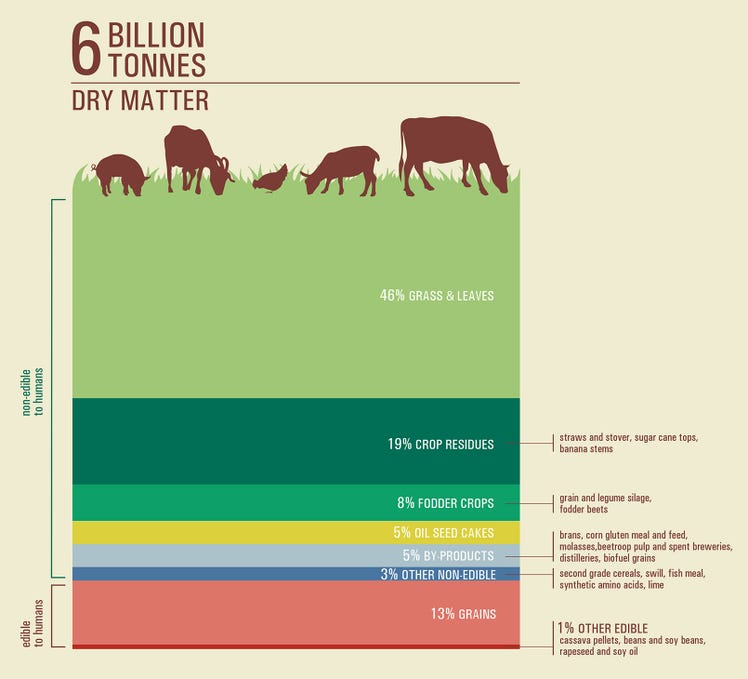FAO insights: Dairy, beef cattle critical to sustainably feeding world
FAO is to be commended for the key insights into the role of livestock in converting forages into edible nutritious human food, and for a better understanding of the progress in the dairy sector of working toward declining emission intensities per unit of output.
February 19, 2019

Livestock - specifically dairy and beef cattle - and their role in nutritiously and sustainably feeding the world are hot topics of debate. Calamitous climate change predictions and deleterious human health impacts due to the consumption of food animals makes one wonder if we will survive as a human race? Will all the lowlands flood globally? Will we all die from cancer? Can we feed the growing global population?
Fortunately, the Food & Agriculture Organization (FAO) is providing excellent insights into the role of livestock in sustainably feeding the world. The recent FAO press release “More Fuel for the Food/Feed Debate” and the FAO and Global Dairy Platform report “Climate Change and the Global Dairy Cattle Sector” provide encouraging scientific facts to fill a critical information void as the debate ensues.
FAO reports, “Animal food sources make a vital contribution to global nutrition and are an excellent source of macro- and micronutrients. Livestock products make up 18% of global calories, 34% of global protein consumption and provides essential micro-nutrients, such as vitamin B12, iron and calcium. Livestock use large areas of pastures where nothing else could be produced. Animals also add to agricultural production through manure production and drought power. Further, keeping livestock provides a secure source of income for over 500 million poor people in many in rural areas.” All extremely positive factors derived from a thriving global livestock sector.
Further information from the FAO paper that was published in Global Food Security, “This study determines that 86% of livestock feed is not suitable for human consumption …” and it “… found that livestock rely primarily on forages, crop residues and by-products that are not edible to humans and that certain production systems contribute directly to global food security, as they produce more highly valuable nutrients for humans, such as proteins, than they consume.” It notes the land needs are, “… about 2.5 billion ha … 77% are grasslands, with a large share of pastures that could not be converted to croplands and could therefore only be used for grazing animals.” Summary, cattle are excellent converters of forages into nutritious beef and dairy products.
The FAO dairy report notes, “Emission intensities, GHG [greenhouse gas] per kilogram of milk, have declined by almost 11% over the period 2005-2015. These declines are recorded in all regions reflecting continued improvements to on-farm efficiency achieved via improved animal productivity and better management.” For understanding, “This study shows that the sector’s GHG emissions have increased by 18% between 2005 and 2015 because overall milk production has grown substantially by 30%, in response to increased consumer demand. The trends in absolute emissions reflect changes in animal numbers as well as changes in the production efficiency within the sector. Between 2005 and 2015, the global dairy herd increased 11%. At the same time, average global milk yield increased by 15%. Increased production efficiency is typically associated with a higher level of absolute emissions (unless animal numbers are decreasing). Yet without efficiency improvements, total GHG emissions from the dairy sector would have increased by 38%.”
A key point from the dairy report, “So while total emissions have increased, dairy farming has become more efficient resulting in declining emission intensities per unit of product.” Thus, in order to sustainably feed the world, innovation and improvements in efficiency will be key to minimizing GHG emissions going forward.
A couple years ago, FAO estimated that we will need 70% more animal products by 2050 to feed the world. These recent reports provide insight into how livestock has helped in feeding the world through better genetic selection, improved feed formulation and enhanced veterinary services. Looking ahead increasing total production and the efficiency of production will be key.
As we think about sustainability, yes, it is likely that livestock will continue to have increased emissions due to the need to grow total output, however, a sharp focus on increased efficiency will provide for declining emissions per unit of product. This near-term focus along with a better understanding of where globally which foods can be produced most efficiently can allow for a long-term approach where food is produced in the area where it can be most efficiently grown and then traded to meet consumer needs worldwide.
Back to the beginning, there are serious questions on sustainably feeding the world a nutritious, balanced and affordable diet. We can do it, but to do it sustainably we need to think how do we bring the least efficient producers to the level of the most efficient producers? How do we further increase the unit of output per the unit of input -- feed conversion and efficiency? How do we accelerate decreasing the emissions per unit of output globally -- reducing livestock’s environmental footprint?
FAO is to be commended for the key insights into the role of livestock in converting forages into edible nutritious human food, and for a better understanding of the progress in the dairy sector of working toward declining emission intensities per unit of output. As one considers a balanced and nutritious diet that includes food animal products, aquaculture, grains, vegetables and fruits, FAO has a critical role to play in leading stakeholder collaboration and facilitating the sharing of best practices globally. Also, governments need to work to eliminate barriers that inhibit agriculture innovation and the flow of food trade. And the private sector, especially farmers, needs to accelerate their adoption of innovation and best practices. The challenge is great, but with scientific advancement, innovation adoption and open food trade the increasing consumer food needs globally can be met sustainably! 
About the Author(s)
You May Also Like





